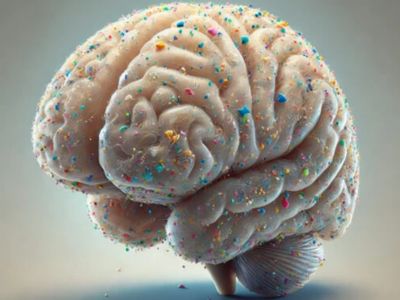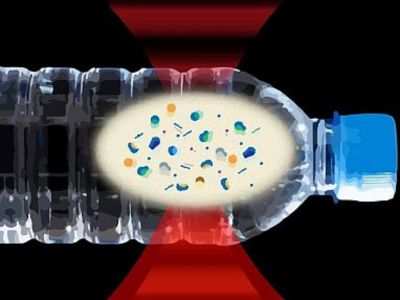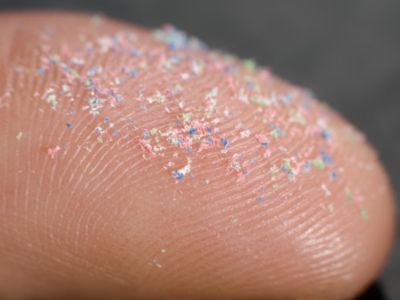Table of Contents
What are Microplastics?
Microplastics, as the name states, are the tiniest bits of plastic that scrape off from products like plastic bottles, plastic chopping boards, plastic heating bowls, and so on. The microplastics are so tiny that they are not visible to a naked eye when mixed in water or food. To explain more, the microplastics present are less than 5 mm in size which are hard to see from the naked eye.
According to the reports and studies held, microplastics are found in the human brain around the world which are emerging serious concerns. HOW?
Let’s dive deeper.
Humans are exposed to microplastics on a daily basis starting from a water bottle to plastic coated bowls and even packed foods. Wherever there is plastic touching your food, water or air, you are by default consuming microplastics. The less we know about it, the more we are consuming it, unknowingly. So, it's time we are aware and take precautions in the situation.
Microplastics in the Brain

Pic Credits: Psypost: Microplastics in brain
Did you know?
In early 2024, researchers analyzed 24 brain samples and found that, on average, around 0.5% of their weight consisted of plastic.
There’s increasing scientific evidence that microplastics are making their way into vital human organs, including the brain, prompting researchers to push for urgent action on plastic pollution.
Tiny plastic particles have been found in the lungs, placentas, reproductive organs, liver, kidneys, joints, blood vessels, and even bone marrow. These microplastics, small fragments less than 5mm in size, are entering our bodies through the air we breathe, the water we drink, and even the food we eat, all due to widespread plastic pollution.
How Do We Consume Microplastics Unknowingly?
Now people might think where is it coming from. The fact is that from the water we drink to the clothes we wear and the food we order, everything can be a source of microplastics.
We don’t realise it but microplastics are the most common addition to our lifestyle these days. Here are some everyday sources that can become a carrier in your daily lives.
- Packaged Food: One of the biggest examples is packaged food. Do you know the plastic boxes that you find aesthetic when your food arrives are actually one of the biggest contributors of microplastics in your daily lives. Luke Coutinho, the advocate of clean and responsible eating, stood against the idea of serving hot cooked food in plastic containers.

Pic Credits: Business Updates by Divyanshi (Linkedin). Luke Coutinho posted a request to Zomato and Swiggy to ditch the plastic containers, which was positively addressed by Deepinder Goyal, Zomato’s CEO.
- Tea bags: Yet another contributor to microplastics is tea bags that we very fondly use considering its convenience. Little do we know we are consuming microplastics along with it. Most people would not know it, but tea bags contain plastic in the material, which releases microplastics when steeped in hot water. So, next time you put that tea bag to simmer, just give yourself a reminder that microplastics can disrupt our body functioning.
- Straws and Paper Cups: Do not think that paper straws or the paper cups you got are free from microplastics. Until you properly check them, they might not be the best choice. Many paper straws and cups are coated with a thin layer of plastic to keep them sturdy and tight. So, when they come in contact with your beverage, it releases microplastics that directly go into your system and disrupt the functioning.
- Cosmetics and Skincare Products: Clean skin care is not just a hashtag that creates a buzz, it actually is the need of the hour. Many everyday cosmetics and personal care products, like hand sanitizers, soaps, toothpaste, and deodorants, often contain microplastics. These tiny plastic particles can be absorbed by the skin or ingested through products like lip balm. A recent report revealed that some exfoliants contain over 10% microbeads (a type of microplastic), and 83% of 138 hand sanitizer brands also contain microplastics.
- Clothing: Clothing materials like polyester, acrylic, and nylon make up about 60% of all fabrics. When washed or worn, they shed tiny microplastic fibers, contributing to 9% of annual microplastic pollution in oceans. To ward off the serious issue, experts suggest opting for non-synthetic fabrics like linen and cotton.
- Bottled Water: Researchers found that a litre of bottled water contains about 2,40,000 tiny plastic particles, with nearly 90% being nanoplastics which are too small to see but small enough to enter the body’s cells, potentially posing health risks. The study also revealed that the microplastic found is more than previous findings which shows how the content of microplastics is increasing.

Pic Credits: National Institutes of Health. Scientists were able to detect hundreds of thousands of previously invisible tiny plastic particles in bottled water with the help of laser.
Health Impacts of Microplastics on Our Brain
Exposure to microplastics and nanoplastics (MNPs) can potentially cross the brain's protective barrier (called the blood-brain barrier), leading to harmful effects on the brain. This may happen by disrupting the balance of inflammation and oxidative stress, altering brain chemicals, and affecting enzymes that are important for nerve function. Microplastics and Nanoplastics (MNPs) can also impact the brain through the gut-brain connection. What’s more concerning is that MNPs can act as carriers, making other harmful substances more dangerous when they enter the body together. Smaller MNPs, in particular, are linked to more serious health risks.
The smaller microplastics might be more harmful than we thought. They could increase the risk of a condition called oxidative stress. This is when harmful molecules build up in our bodies and cause damage to cells, which can lead to inflammation. And when inflammation happens over time, it can contribute to diseases like cardiovascular disease, which affects the heart and blood vessels.

Pic Credits: Yale E360; Microplastics under microscope
But that's not all. Researchers discovered even more concerning links. They found that microplastics might be tied to fertility problems, making it harder for animals to reproduce. There's also evidence suggesting that exposure to microplastics could increase the risk of certain cancers.
On top of that, microplastics are doubted to mess with important systems in our bodies. For example, the endocrine system, which controls our hormones, and the immune system, which helps us fight off diseases, can be disrupted by these tiny particles. This means they can affect how our bodies function and defend themselves.
Even more surprisingly, some studies show that microplastics could impact learning and memory. So, the more we learn about microplastics, the clearer it becomes that they aren't just an environmental problem, they're a serious health risk too.
So, what’s the solution? Sure, we are living around them which makes it hard to avoid them, but, a few steps can help reduce human exposure to the microplastics.
What’s the Solution?
Microplastics are everywhere, so what do we do to avoid them completely? Here are some alternatives that will help reduce the exposure to the microplastics.
#1 Choose Cotton or Linen Over Synthetic Fabrics: You should know that around 60% of clothing is made from plastics like polyester, acrylic, and nylon. When these fabrics are washed or worn, they release tiny microplastic fibers called microfibres into the environment. The solution is to either choose pure cotton, linen or natural fabrics or rewear your clothes more often without washing much.
#2 Swap Loose Tea With Tea Bags: We know that tea bags can release microplastics when heated or simmered which brings us to an amazing alternative of using loose tea or the muslin tea bags. Just put a spoonful of loose tea and you are done. Buy them here.
#3 Switch Your Straws: If you are a regular user of straws at home, make sure you switch to other alternatives like stainless steel or the bamboo straws. Before buying the straws, double check with the shopkeeper if the straws have any additional coating.
#4 Shift to Glass or Steel Bottles: For people who use plastic bottles even now, you are just accumulating the content of microplastics in your body. Instead, opt for glass or stainless steel bottles that’ll reduce your exposure to microplastics. Buy it here.
#5 Rethink Your Skincare: You should rethink what skincare you are using. It may contain microplastics, specifically primary microplastics that are intentionally added to enhance texture. Say a big NO to the skincare that contains polyethylene (PE) or polypropylene (PP).
Microplastics in the human brain and the overall body is a pressing issue that definitely should be addressed at the earliest. Beware of what you consume for a healthy future.
Disclaimer: Please keep your healthcare provider in the loop before introducing any new food item or beauty product into your lifestyle, especially if you have a medical health condition or are on medications. In case you are allergic to certain foods, please avoid them.
You can reach out to us for expert assistance at +917059700700
Or write to us at [email protected]
Do you have any questions? Feel free to drop them in the comment box below.




Comments